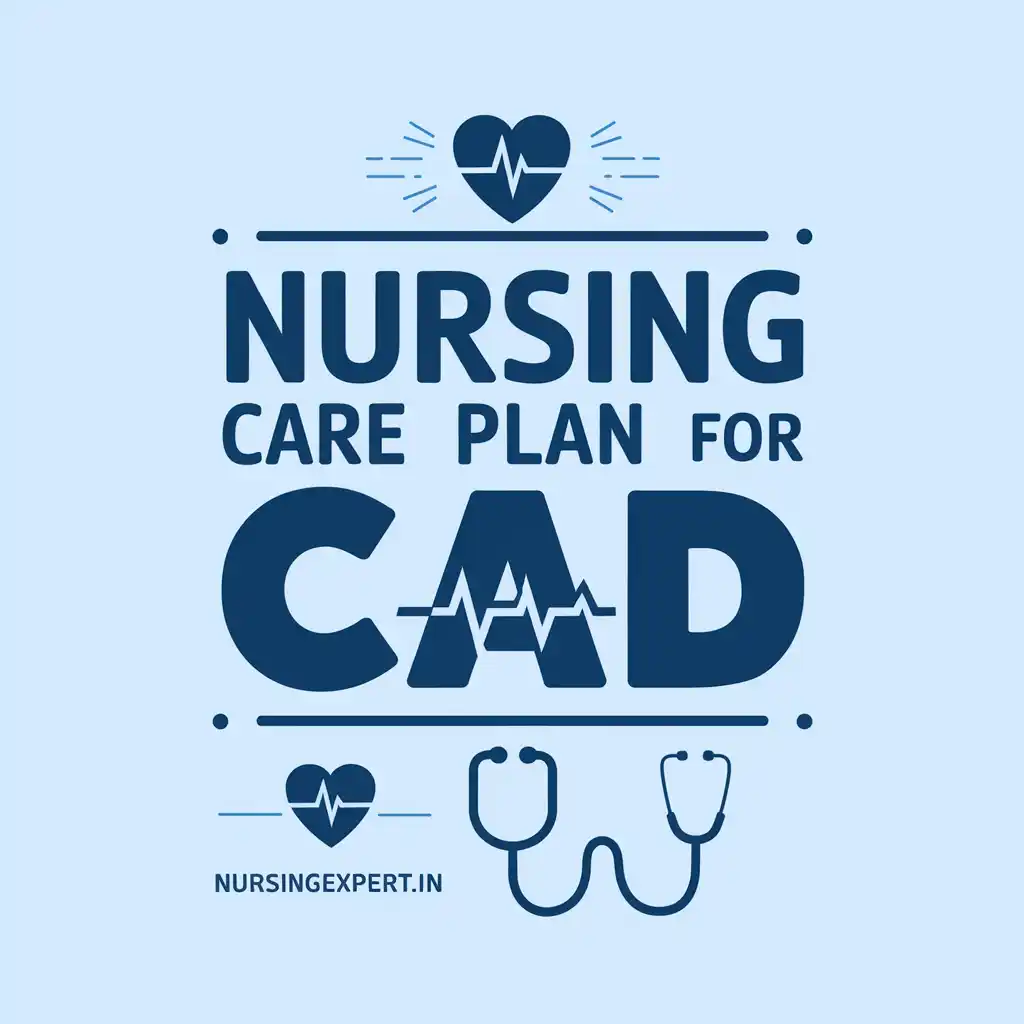Coronary Artery Disease (CAD) ranks among the most prevalent and life-threatening conditions globally. It occurs when plaque—composed of cholesterol, fat, and other substances—accumulates in the coronary arteries, restricting blood flow to the heart muscle. This narrowing can trigger symptoms like chest pain, shortness of breath, and fatigue, and in severe cases, it may lead to heart attacks or heart failure. Nurses serve as frontline caregivers in managing CAD, playing a critical role in assessing patients, administering treatments, and educating individuals and families about the condition.
Thank you for reading this post, don't forget to subscribe!
1. Introduction
Coronary Artery Disease (CAD) stands as a major public health challenge. According to the Centers for Disease Control and Prevention (CDC), it claims approximately 370,000 lives annually in the United States alone (CDC, 2023). Globally, millions more suffer from its effects, making it a leading cause of death and disability. The disease emerges when plaque builds up inside the coronary arteries, which supply oxygen-rich blood to the heart. Over time, this buildup narrows the arteries, reducing blood flow and straining the heart. Without proper management, CAD can escalate into critical events like heart attacks, where a blocked artery cuts off oxygen to part of the heart muscle.


Nurses occupy a pivotal position in CAD care. They monitor patients for early warning signs, deliver medications, and guide lifestyle changes that can slow the disease’s progression. Beyond clinical tasks, nurses provide emotional support and education, empowering patients to take control of their health. This guide offers 10 essential nursing care plans tailored to CAD management. Each plan addresses a specific aspect of care, from diagnosis to patient education, ensuring nurses have practical tools to enhance outcomes.
The importance of CAD care cannot be overstated. As populations age and lifestyle-related risk factors—like poor diet and inactivity—rise, the demand for skilled nursing care grows. This guide equips nurses with the knowledge and strategies needed to meet that demand, blending evidence-based practices with real-world applicability.
2. Understanding Coronary Artery Disease
CAD fundamentally involves the narrowing of the coronary arteries due to plaque buildup, a process known as atherosclerosis. These arteries are vital because they deliver oxygen and nutrients to the heart muscle. When plaque accumulates, it restricts blood flow, depriving the heart of oxygen. This oxygen shortage often manifests as chest pain, or angina, a hallmark symptom of CAD. Other signs include shortness of breath, fatigue, and, in some cases, pain radiating to the arms or jaw. If untreated, CAD can culminate in a heart attack, where a clot completely blocks an artery.
Distinguishing CAD from other heart conditions helps clarify its unique challenges. For instance, heart failure occurs when the heart cannot pump blood effectively, often as a downstream effect of CAD. In contrast, arrhythmias involve irregular heart rhythms, which CAD can also trigger. Nurses frequently encounter patients confused about these terms, so explaining them in simple language—like “CAD narrows your heart’s blood vessels, while heart failure means your heart struggles to pump”—builds understanding and trust.
CAD’s impact varies widely. Some patients experience mild angina during physical activity, while others face severe limitations or sudden emergencies. Risk factors like smoking, high cholesterol, and hypertension amplify its severity. Nurses must recognize these variations to tailor care effectively. Early detection, often through routine assessments, remains a cornerstone of CAD management, and nurses are instrumental in identifying symptoms and coordinating diagnostic efforts.
3. How CAD Develops
The development of CAD is a slow, progressive process rooted in atherosclerosis. It begins when cholesterol, fats, and calcium deposit along the inner walls of the coronary arteries, forming plaque. Initially, these deposits are soft and fatty, known as fatty streaks. Over years, they harden into fibrous plaque, narrowing the arteries and stiffening their walls. In advanced stages, plaque may rupture, triggering blood clots that can block the artery entirely—a common cause of heart attacks.
Several factors accelerate this process:
- Smoking: Toxins in tobacco damage artery linings, inviting plaque buildup.
- High Blood Pressure: Excess pressure stresses artery walls, making them prone to damage.
- Elevated Cholesterol: High levels of low-density lipoprotein (LDL) cholesterol contribute directly to plaque.
- Diabetes: Uncontrolled blood sugar harms blood vessels, hastening atherosclerosis.
- Sedentary Lifestyle: Lack of exercise weakens the heart and promotes obesity, a CAD risk factor.
- Genetics: A family history of CAD increases susceptibility.
CAD evolves through distinct stages:
- Fatty Streaks: Small, reversible deposits appear in childhood or young adulthood.
- Fibrous Plaque: Deposits grow, harden, and begin restricting blood flow by middle age.
- Complicated Plaque: Plaque ruptures, forming clots that may cause acute events like heart attacks.
Nurses use this knowledge to identify at-risk patients and intervene early. By addressing modifiable risks—like smoking or poor diet—they help slow CAD’s progression, improving long-term outcomes.
4. Assessing CAD
Accurate assessment forms the foundation of CAD care. Nurses begin by gathering a detailed patient history. They ask about symptoms like chest pain (its location, duration, and triggers), shortness of breath, or unusual fatigue. They also explore risk factors: Does the patient smoke? Is there a family history of heart disease? This information provides critical context.
The physical exam follows. Nurses measure vital signs—heart rate, blood pressure, and respiratory rate—looking for abnormalities like a rapid pulse or hypertension. They listen to the heart with a stethoscope for murmurs or irregular beats and check for signs like leg swelling, which may suggest heart strain. Pale skin or sweating can also signal poor circulation.
Diagnostic tests confirm CAD:
- Electrocardiogram (ECG): Records heart electrical activity, revealing ischemia or past heart damage.
- Stress Test: Monitors the heart during exercise, showing how it performs under strain.
- Coronary Angiography: Injects dye into arteries, visualized via X-ray to pinpoint blockages.
- Blood Tests: Measure cholesterol levels and markers like troponin, indicating heart injury.
Nurses prepare patients for these tests, explaining their purpose in simple terms: “This test shows us how your heart is working.” They also monitor post-test reactions, such as discomfort from angiography. Thorough assessments ensure accurate diagnoses and guide subsequent care plans.
5. Nursing Diagnoses for CAD
Nursing diagnoses, standardized by NANDA International, identify patient problems and direct interventions. For CAD, common diagnoses include:
- Decreased Cardiac Output: The heart pumps less blood due to narrowed arteries, causing fatigue or low blood pressure. Nurses spot this through symptoms or ECG changes.
- Acute Pain: Angina arises when the heart lacks oxygen, often described as tightness or pressure.
- Impaired Gas Exchange: Reduced oxygen in the blood leads to shortness of breath, visible in low oxygen saturation readings.
- Anxiety: Patients fear worsening health or procedures, showing as restlessness or elevated heart rate.
- Deficient Knowledge: Many lack understanding of CAD, its risks, or treatments, hindering self-care.
Each diagnosis targets a specific issue. For example, “Acute Pain” reflects angina’s impact, while “Deficient Knowledge” addresses gaps in understanding medication or diet. Nurses assess these conditions through observation and patient reports, then craft interventions to address them, ensuring care aligns with individual needs.
6. Nursing Interventions
Interventions translate diagnoses into action. Nurses implement strategies to stabilize patients and promote recovery. Key interventions include:
Medication Administration
Nurses administer drugs like nitroglycerin to relieve angina by dilating blood vessels. Beta-blockers slow the heart rate, reducing its workload, while antiplatelet agents like aspirin prevent clots. Nurses ensure proper dosing and monitor for side effects, such as dizziness from nitroglycerin.
Oxygen Therapy
When oxygen levels drop, nurses deliver supplemental oxygen via nasal cannula or mask. This boosts blood oxygen, easing the heart’s burden and improving breathing.
Monitoring Vital Signs
Frequent checks of heart rate, blood pressure, and oxygen saturation detect changes early. A sudden drop in blood pressure or irregular pulse may signal complications, prompting swift action.
Lifestyle Counseling
Nurses guide patients toward healthier habits: quitting smoking, eating low-fat foods, and exercising moderately (e.g., 30 minutes of walking daily). They offer practical advice, like replacing butter with olive oil.
Patient Education
Nurses explain CAD’s causes and treatments clearly: “Plaque blocks your arteries, but medicine and diet can help.” They teach patients to recognize worsening symptoms, like prolonged chest pain, and seek help.
Post-Procedure Care
After interventions like angioplasty, nurses monitor for bleeding at catheter sites and ensure rest. They educate patients on recovery, reinforcing instructions like avoiding heavy lifting.
These interventions enhance heart function, reduce symptoms, and prevent complications. Nurses adapt them to each patient’s condition and response.
7. Special Care Tips
Specialized care addresses unique CAD challenges:
Nitroglycerin Administration
Nurses check blood pressure before giving nitroglycerin, as it can cause a sudden drop, leading to dizziness. They advise patients to sit or lie down during administration and explain common side effects like headaches.
Post-Cardiac Catheterization Care
After procedures, nurses inspect insertion sites for bleeding or swelling and enforce bed rest. They monitor vital signs and provide comfort, ensuring patients feel secure.
Managing High Cholesterol
Nurses recommend cholesterol-lowering foods—oats, salmon, almonds—and reinforce statin use. They explain how these steps shrink plaque over time.
Addressing Anxiety
Nurses teach deep breathing or guided relaxation to calm patients. They provide clear, reassuring information about treatments, reducing fear and supporting heart health.
These tips refine care, tackling specific issues with precision and empathy.
8. Teaching Patients and Families
Education empowers patients and families to manage CAD effectively. Nurses tailor teaching to individual needs, covering:
CAD Basics
Using visuals, nurses explain plaque buildup and its effects: “Your heart needs blood, but these blockages stop it.” Simple analogies clarify complex ideas.
Healthy Lifestyle
Nurses promote diets low in salt and saturated fat—think grilled chicken over fried—and encourage light exercise. They set realistic goals, like walking 10 minutes daily, building to more.
Medication Adherence
Nurses stress taking drugs as prescribed, explaining benefits (“This keeps your arteries open”) and side effects (“You might feel tired at first”). Pill organizers aid compliance.
Warning Signs
Patients learn to recognize red flags—severe chest pain, sudden weakness—and act fast by calling 911. Nurses reinforce urgency without causing panic.
Family Involvement
Families assist with cooking healthy meals or reminding patients about medications. Nurses include them in sessions, fostering a supportive network.
Education boosts confidence and adherence, key to long-term CAD control.
9. Teamwork in CAD Care
CAD management thrives on collaboration. Nurses partner with:
- Cardiologists: Diagnose blockages and recommend treatments.
- Dietitians: Craft heart-healthy meal plans.
- Physical Therapists: Design safe exercise routines.
- Pharmacists: Adjust medications and monitor interactions.
- Social Workers: Address emotional or financial barriers.
Nurses coordinate these efforts, ensuring seamless care. For example, they relay a patient’s dietary progress to the dietitian, enhancing teamwork and outcomes.
10. Sample Nursing Care Plan
This table outlines a practical CAD care plan:
| Assessment | Diagnosis | Goal | Intervention | Action | Reason | Result |
|---|---|---|---|---|---|---|
| Chest pain during activity. Heart rate 110 bpm. BP 140/90 mmHg. ECG shows ischemia. | Decreased Cardiac Output | Pain to 3/10 in 1 hour. Stable vitals. | Give nitroglycerin, beta-blockers. Monitor vitals. | Administer drugs. Reposition patient. Check every 15 minutes. | Improves blood flow, reduces strain. | Pain eases. Vitals stabilize. |
| Patient anxious about health. | Anxiety | Less anxiety in 24 hours. | Teach relaxation. Reassure. | Show breathing exercises. Explain calmly. | Lowers stress, aids heart. | Patient calms. Heart rate drops. |
| High-fat diet. High LDL. | Deficient Knowledge | Learn healthy diet in 1 day. | Educate on diet. Offer meal ideas. | Share brochures. Suggest swaps. | Lowers cholesterol. | Patient adopts better diet. |
This plan provides a roadmap for consistent, effective care.
11. Frequently Asked Questions (FAQs)
- What is CAD? Plaque narrows heart arteries, limiting blood flow.
- What are CAD symptoms? Chest pain, breathlessness, fatigue.
- How is CAD diagnosed? Via history, exams, ECGs, and tests.
- What treatments work? Drugs, lifestyle changes, procedures.
- Can CAD be prevented? Yes, with healthy habits.
- How do nurses help? They assess, treat, and educate.
- CAD vs. heart attack? CAD is the condition; a heart attack is an event.
- Why educate patients? It improves management and prevents worsening.
12. Conclusion
Nurses are vital in CAD care, blending clinical skill with compassion. This 10-plan guide equips them to assess, treat, and educate effectively, enhancing patient lives. Clear, actionable, and comprehensive, it supports nurses, students, and families in tackling CAD’s challenges.
13. References
- CDC. (2023). Heart Disease Facts. https://www.cdc.gov/heartdisease
- Mayo Clinic. (2023). Coronary Artery Disease. https://www.mayoclinic.org
- American Heart Association. (2023). Understanding CAD. https://www.heart.org
- NANDA International. (2022). Nursing Diagnoses. https://www.nanda.org


